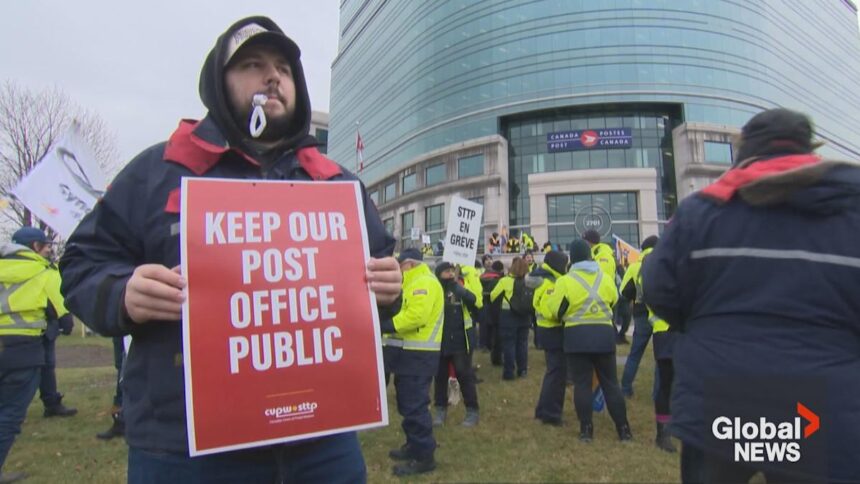The mail truck that typically rumbles down my street each afternoon hasn’t appeared today. Across neighborhoods throughout Toronto and beyond, Canadians are bracing for a potential disruption to a service many still rely on despite the digital revolution.
Canada Post and the Canadian Union of Postal Workers (CUPW) have hit yet another roadblock in their negotiations, with the Crown corporation announcing this week it’s suspending talks. The timing couldn’t be more precarious as we edge closer to what could become a nationwide postal disruption.
“We’re at an impasse,” said a clearly frustrated Jan Simpson, CUPW National President, during a press conference yesterday. “Canada Post continues to propose a two-tier wage system that would create inequity among workers doing the same jobs.”
The postal service serves as a lifeline for rural communities, small businesses, and seniors who depend on reliable mail delivery for everything from prescription medications to government documents. Now, that lifeline dangles by increasingly frayed threads.
At the heart of this dispute are several key issues that have proven difficult to resolve. CUPW, representing about 55,000 postal workers, is seeking wage increases that keep pace with inflation, improved working conditions, and better job security. Canada Post, meanwhile, points to financial pressures and changing market conditions as constraints on what it can offer.
The numbers tell part of the story. Canada Post reported a loss of $548 million before tax in 2023, a stark reminder of the financial challenges facing traditional mail services in our increasingly digital world. Parcel volumes, which surged during pandemic lockdowns, have stabilized but haven’t maintained their COVID-era peaks.
Yet postal workers argue these financial challenges shouldn’t come at their expense. “Our members kept this country connected during the pandemic, often at risk to their own health,” Simpson emphasized. “Now we’re being asked to accept conditions that would erode decades of progress.”
For small business owners like Melissa Chen, who runs an online craft supply store in Winnipeg, the timing couldn’t be worse. “We’re heading into the holiday shopping season, and about 40% of my shipments go through Canada Post,” she told me. “I’m already looking at alternative carriers, but their rates are significantly higher, which means I’ll either have to absorb those costs or pass them on to customers.”
The potential economic impact extends beyond individual businesses. The Canadian Federation of Independent Business estimates that a prolonged postal disruption could cost small and medium-sized enterprises millions in delayed payments, lost customers, and increased shipping costs.
Canada Post spokesperson Jon Hamilton defended the corporation’s position in a statement: “We need to adapt our operations and cost structure to reflect the reality of today’s market. Mail volumes continue to decline while costs rise – that’s simply unsustainable without significant changes.”
The federal government has remained relatively hands-off so far, with Labour Minister Seamus O’Regan urging both sides to continue negotiations. However, history suggests government intervention may be inevitable if a strike or lockout materializes. During the 2018 postal dispute, Ottawa eventually legislated workers back to work after rotating strikes disrupted service for more than a month.
Royal Bank of Canada economist Nathan Janzen notes that while a postal disruption would be inconvenient, its macroeconomic impact would likely be limited. “Unlike the 1970s or ’80s, we have many more options for communication and shipping today,” he explained. “But there are still vulnerable populations and businesses that would feel significant effects.”
For rural Canadians like Donna McDonald in Newfoundland’s Great Northern Peninsula, those effects could be particularly acute. “We don’t have reliable internet here, and the nearest courier service drop-off is over an hour’s drive away,” she said. “Canada Post is our connection to the rest of the country.”
The technological landscape has certainly changed since Canada Post’s last major labor dispute. Digital alternatives exist for many services, from electronic bill payments to email. Yet the postal service maintains a unique place in Canada’s infrastructure – handling everything from passport applications to cannabis deliveries.
Canada Post has implemented contingency plans, advising business customers to make alternative arrangements for time-sensitive mailings. But those alternatives often come with higher costs and less comprehensive coverage, particularly for rural and remote areas.
As negotiations remain suspended, both sides appear to be digging in. CUPW has a strike mandate from its members but hasn’t yet issued the required 72-hour notice of job action. Canada Post could also lock out workers – a scenario that grows more likely with each passing day of stalled talks.
For ordinary Canadians, the uncertainty is the most immediate impact. Julie Patel, who manages a medical clinic in Edmonton, worries about patients receiving test results and appointment notices. “We’ve started calling patients directly for urgent matters, but that’s not sustainable long-term,” she explained. “And many of our elderly patients strongly prefer physical mail.”
As Canada’s population ages, this preference for traditional mail service becomes increasingly significant. Digital alternatives that seem obvious to younger Canadians present real barriers for many seniors.
The coming days will be critical. If talks don’t resume soon, Canadians may find themselves facing the first national postal disruption since 2018. For a service that dates back to 1867, it’s another chapter in the ongoing challenge of adapting a historical institution to modern realities.
What’s clear is that despite predictions of its demise in the digital age, enough Canadians still rely on postal service that a disruption would be felt across communities, businesses, and households nationwide. The question isn’t whether Canada Post remains relevant – it’s how the institution will evolve to balance operational sustainability with the needs of both its workers and the public it serves.
For now, Canadians would be wise to prepare for potential disruptions while hoping that cooler heads prevail at the bargaining table. The mail must go through – but first, Canada Post and its workers need to agree on the terms of delivery.






